Family : Cytinaceae

Text © Prof. Pietro Pavone

English translation by Mario Beltramini
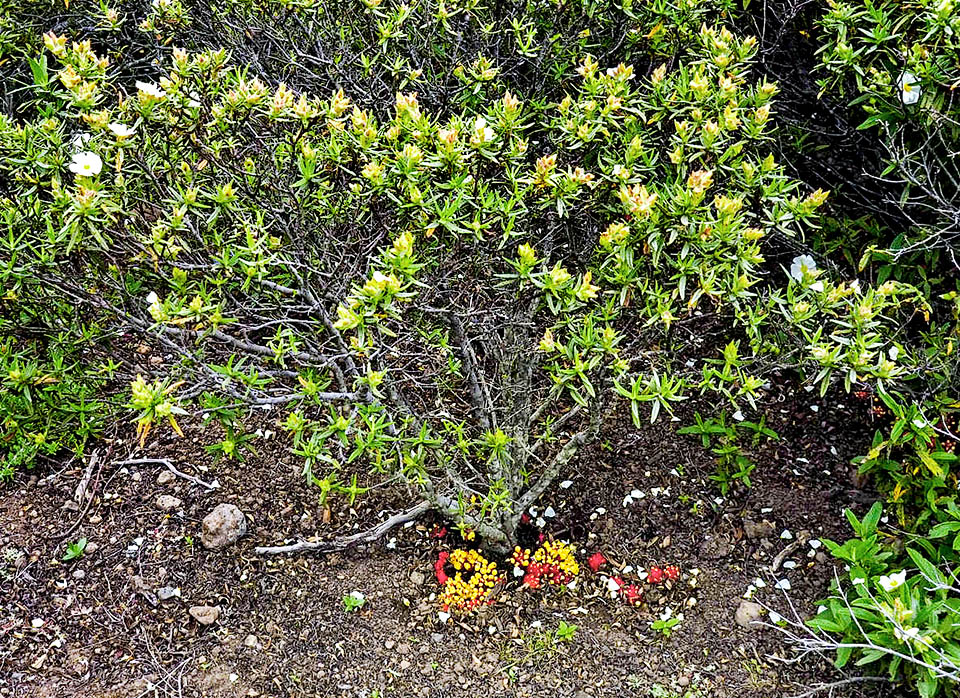
Present in Mediterranean environment up to about 800 m of altitude Cytinus hypocistis is a parasite of white flower Cistus and other Cistaceae like Halimium halimifolium © Wolfgang Bettighofer
Cytinus hypocistis (L.) L. is a holoparasitic plant, having no capacity for photosynthesis, belonging to the family
Cytinaceae A. Rich. of the order Malvales. In the past the family was included in the order Rafflesiales but molecular studies have indicated its nesting inside the order Malvales (APG III, 2009).
The genus Cytinus includes eight species with a disjointed distribution on two centres of diversity, one in the Mediterranean area (Cytinus hypocistis; Cytinus ruber) and the other in southern Africa (Cytinus capensis; Cytinus sanguineus; Cytinus visseri) and Madagascar (Cytinus baronii; Cytinus glandulosus; Cytinus malagasicus).
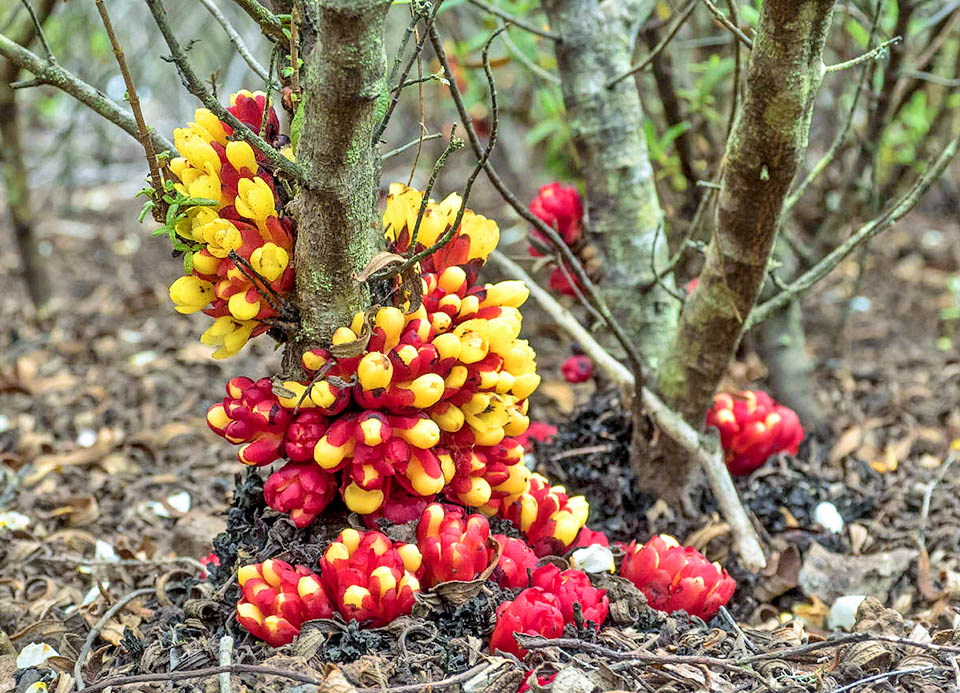
Has no leaves for photosynthesis and so it grows with invasive filaments, similar to fungal hyphae, in the host roots, getting out only in spring for blooming © Wolfgang Bettighofer
There are no fossils of Cytinus, however estimations based on molecular studies (single copy nuclear genes) place its origin at 72,1 million years ago.
Cytinus hypocistis is a species diffused in the Mediterranean and Macaronesian regions, in environments of shrub and of garrigue especially on siliceous soils, from the sea level up to 800 m of altitude.
Particularly, it is found in Aegean Islands, Albania, Algeria, Balearic Islands, Crete, Canary Islands, Corsica, Cyprus, France, Greece, Italy, Lebanon-Syria, Libya, Morocco, Portugal, Spain,Tunisia, Turkey, Yugoslavia.
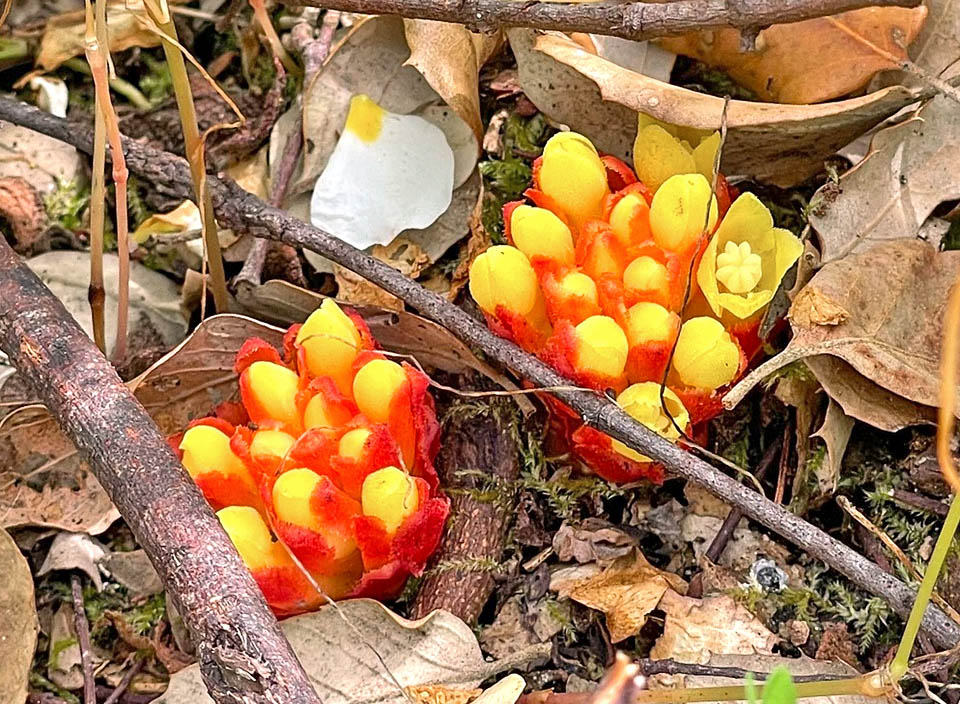
It does not exceed 8 cm and the showy flowers, here in bud, are merged in a spike flower-head shaped inflorescence © joaoalmeida
It is an obligate parasite of plants of the family Cistaceae like Cistus monspeliensis, Cistus salviifolius with white flowers, but also of species of other genera like Halimium halimifolium.
The name of the genus Cytinus comes from the old Greek “κῠτῐνος”(cytinos), cytinus, from kytos, hollow vessel, name of the calyx of the flower of the pomegranate (Theophrastos and Hipppocrates) resembling the flowers of this plant. The term hypocistis comes from the Greek “ὑπὸ” (hypó), under and from Cistus, rockrose, to indicate that it is found under the rockroses.
The Italian name is ipocisto comune, ipocisto giallo, citino giallo. In English it is called rockrose parasite;in French cytinelle cytinet and Gelber Zistrosenwürger in German.
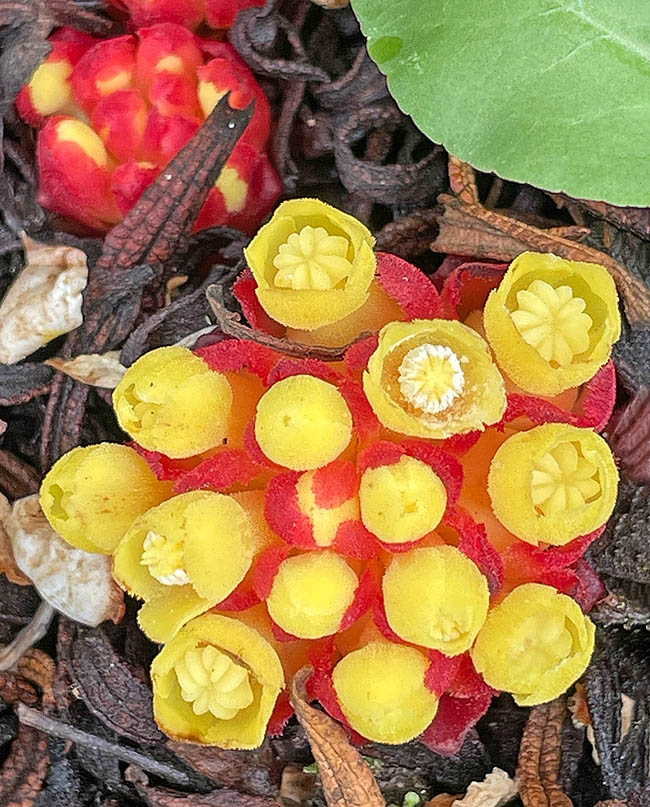
Flowers, with four toothed yellow perigonium, measure 12-15 mm and elegantly contrast with the red apical leaves. The male ones, with funnel-shaped perigonium narrow under the lobes, are placed at the centre and female around © Wolff Christiane
This species was validly described in 1764 by Carl Linnaeus (1707-1778) in Addenda to the sixth edition of Genera Plantarum (Gen. Pl., ed. 6.: 566 -1764).
Cytinus hypocistis is a small monoecious plant, perennial, unable to make photosynthesis and consequently obligate parasite (holoparasite) of a host plant from which it gets its nourishment.
Its vegetative parts are filamentous, similar to fungal hyphae, and develop inside the roots of the host. This endophytic structure is similar to that of Cytinus ruber independently from the host species.
The plant is visible only when blooming when it reaches a height of no more than eight centimetres.
The stem is short, covered by small scaly, 5 x 10-15 mm, leaves, fleshy, alternate and having no stipules, amply oblanceolate, keeled, irregularly toothed-ciliate and thickly imbricated that give it a claviform appearance.
The lower leaves are whitish, the upper ones are yellowish or reddish in particular in the apical part. The flowers are grouped in a spike-like inflorescence flower-head shaped.
The flowers are regular with yellow four-toothed perigonium. The male flowers, sited inside the inflorescence, measure 12-15 (17) mm with funnel-shaped perigonium, narrowed under the lobes. The stamens are 8-10 merged for the filaments to form a column. The female flowers, with flask-shaped papillose perigonium (lageniform), measure 12-15 mm and are placed outside the inflorescence.
Flowering takes place from April to May. The fruit is a sort of berry of yellow colour whose covering comes from the perigonium (acrosarco fruit). The seeds are immersed in viscous pulp. The pollination is made chiefly by ants who, while looking for nectar, get in touch with the reproductive organs.
Cytinus hypocistis in the past, besides being a plant utilized as food, especially during famine periods, was employed also in a vast choice of traditional health practices. In fact, they prepared decoctions or tinctures to treat dysentery, throat cancer, and for eye inflammation.
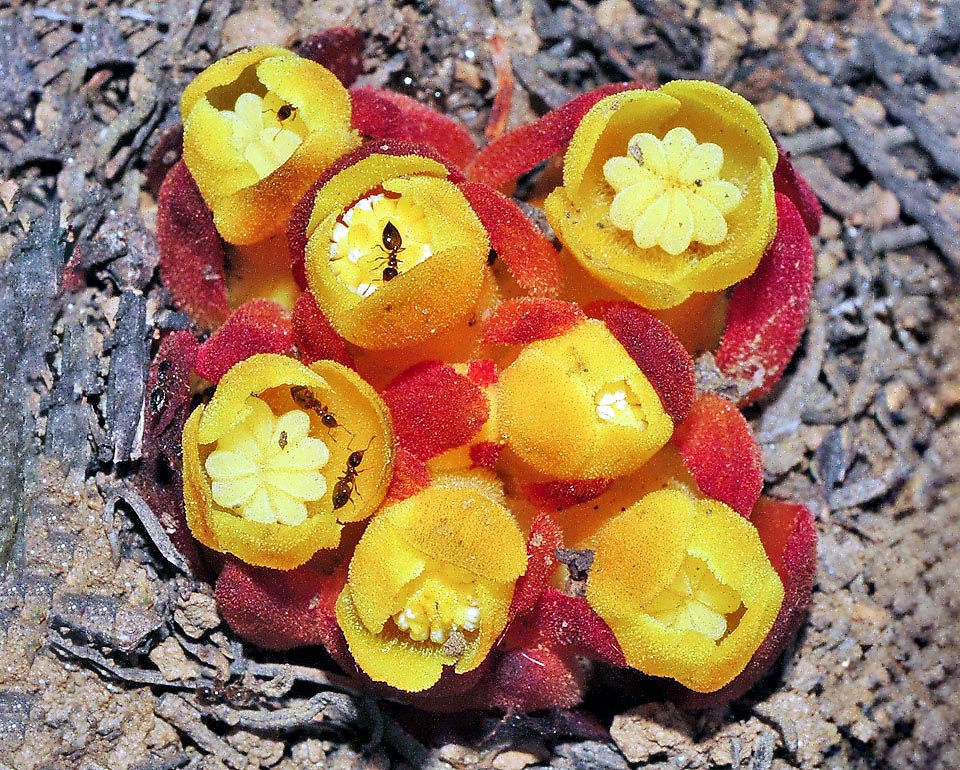
Pollination is entrusted mainly to ants. The plant, once consumed especially during famine times, displays various medicinal properties © faluke
Recent studies have confirmed that this plant has antibacterial, antioxidant, antidiabetic, anti-inflammatory and antiproliferative properties.
Cytinus hypocistis has five recognized valid species: Cytinus hypocistis subsp. hypocistis; Cytinus hypocistis subsp. macranthus Wettst. (Algeria, Morocco, Portugal, Spain, Tunisia); Cytinus hypocistis subsp. orientalis Wettst. ex Hayek (Cyprus, Crete, East Aegean, Greece, Lebanon, Libya, Turkey); Cytinus hypocistis subsp. pityusensis Finschow (Balearic Islands); Cytinus hypocistis subsp. subexsertum Finschow ex G.Kunkel (Canary Islands).
Synonyms: Asarum hypocistis L. (1753); Hypocistis hypocistis (L.) Linding. (1926); Thyrsine hypocistis (L.) Walp. (1852).
